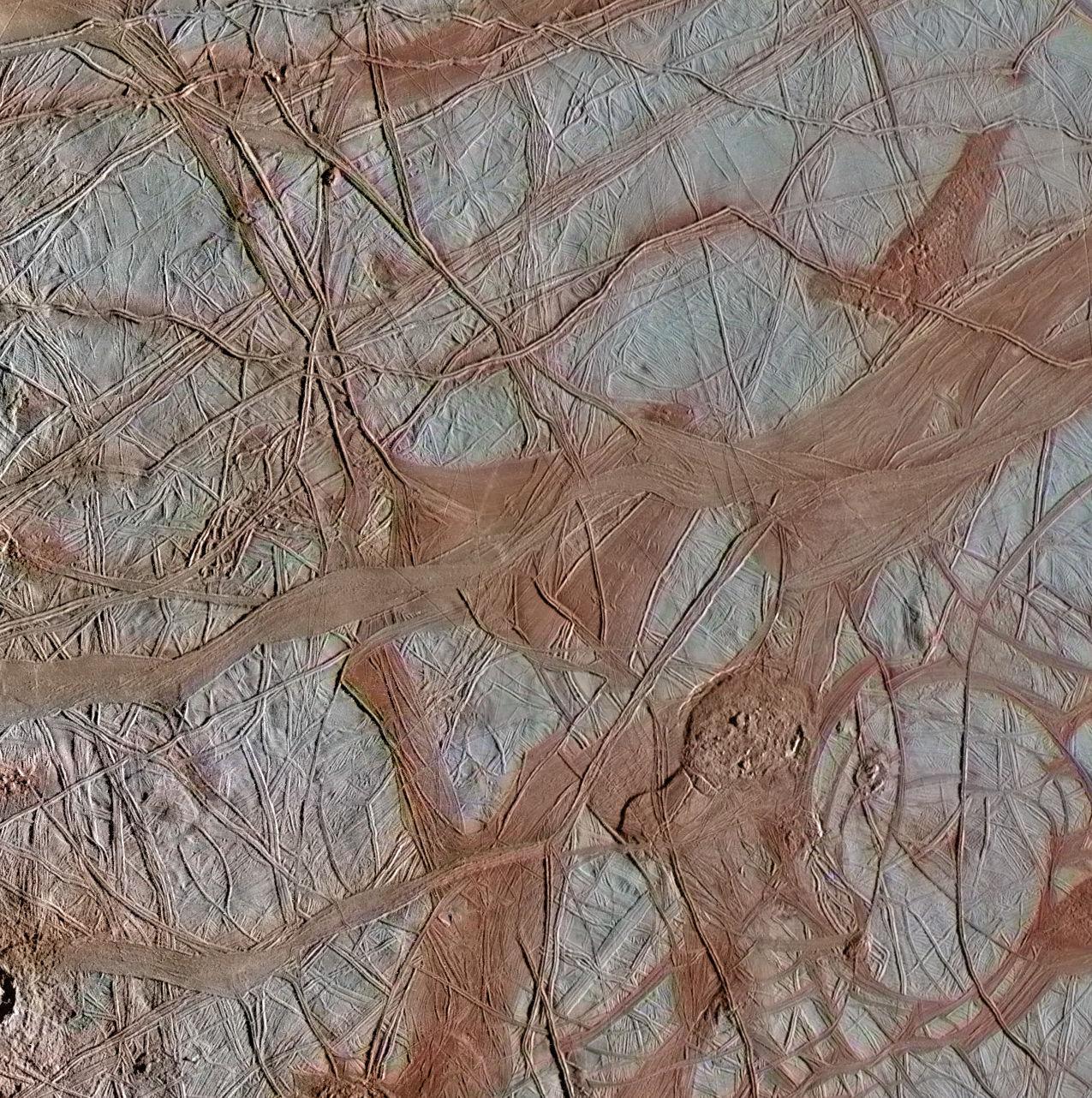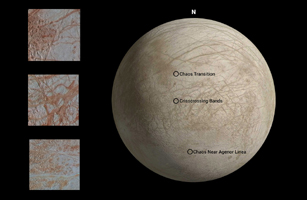
|
Crisscrossing Bands
- Click the image above for a larger view
- Full-Res JPEG (1275 x 1282) (490.0 kB)
- Full-Res TIFF (1275 x 1282) (4.9 MB)
Caption:

Figure 1
The surface of Jupiter's moon Europa features a widely varied landscape, including ridges, bands, small rounded domes and disrupted spaces that geologists called "chaos terrain." This newly reprocessed image, along with two others along the same longitude (see PIA23871 and PIA23873 ), were taken by NASA's Galileo spacecraft on Sept. 26, 1998, and reveal details of diverse surface features on Europa.
All three images were captured along the same longitude of Europa as Galileo flew by on Sept. 26, 1998, in the spacecraft's 17th orbit of Jupiter (orbit E17). It was the eighth of Galileo's 11 targeted flybys of Europa. High-resolution images were taken through a clear filter in grayscale (black and white). Using lower-resolution, color images of the same region from a different flyby (orbit E14), technicians recently mapped color onto the higher-resolution images.
(Orbit E14 resulted in this global view of Europa (see PIA19048 ). The color information gathered on that flyby was used to reprocess these new images.)
Enhanced-color images like these allow scientists to highlight geologic features with different colors, which are related to chemical compositions of the surface. Areas that appear light blue or white are made up of relatively pure water ice, and reddish areas have more non-ice materials.
This image shows a region of Europa's surface covered with ridges and bands, with a few small disrupted chaos regions. The long, linear ridges and bands that crisscross Europa's surface are thought to be related to the response of Europa's icy surface crust as it is stretched and pulled by Jupiter's strong gravity. Ridges, a common surface feature type, may form when a crack in the surface opens and closes repeatedly, building up a feature that's typically a few hundred yards tall, a few miles wide and that can stretch horizontally for thousands of miles.
In contrast, bands are locations where a crack appears to have continued pulling apart horizontally, producing large, wide, relatively flat features. This image shows both ridges and bands, which interact with each other in complex ways that are somewhat similar to tectonic activity on the Earth.
The image resolution is 244 yards (223 meters) per pixel, and this image depicts an area about 180 miles (285 kilometers) across.
This image was produced by Mario Valenti at the SETI Institute in Mountain View, Calif.
Figure 1 indicates the locations on Europa depicted in the newly processed images, with the cross-cutting band noted by the middle marker. This image is centered approximately at -10.5 degrees south latitude, and 135.0 degrees east positive longitude.
Background Info:
The Galileo mission was managed by NASA's Jet Propulsion Laboratory, a division of Caltech in Pasadena, California, for NASA's Science Mission Directorate in Washington. Additional information about Galileo and its discoveries is available on the Galileo mission home page at http://solarsystem.nasa.gov/galileo/ .
More information about Europa and Europa Clipper is available at europa.nasa.gov .
Cataloging Keywords:
| Name | Value | Additional Values |
|---|---|---|
| Target | Europa | Jupiter |
| System | Jupiter | |
| Target Type | Satellite | Planet |
| Mission | Galileo | |
| Instrument Host | Cassini Orbiter | Galileo Orbiter |
| Host Type | Orbiter | |
| Instrument | Imaging Science Subsystem (ISS) | |
| Detector | ||
| Extra Keywords | Color, Mountain, Water | |
| Acquisition Date | ||
| Release Date | 2020-05-01 | |
| Date in Caption | ||
| Image Credit | NASA/JPL-Caltech/SETI Institute | |
| Source | photojournal.jpl.nasa.gov/catalog/PIA23872 | |
| Identifier | PIA23872 | |
